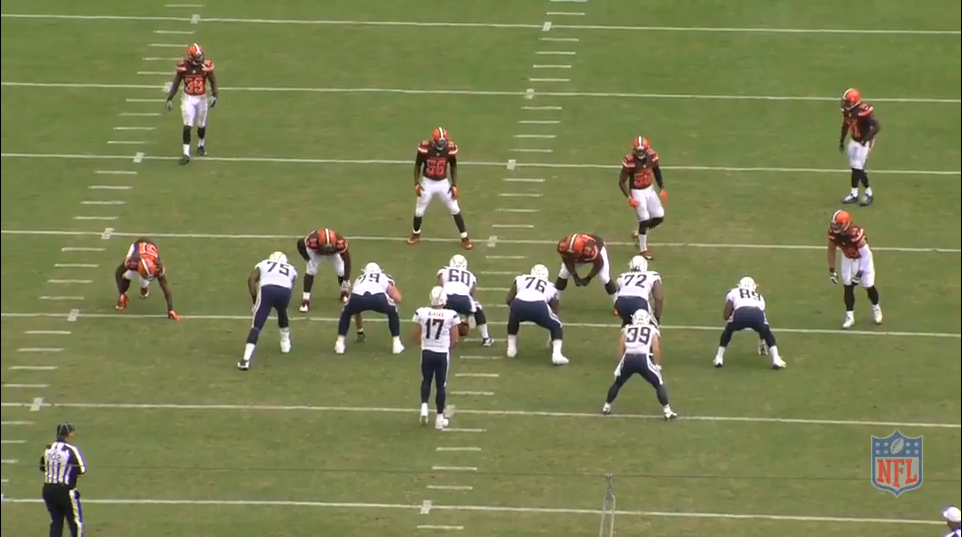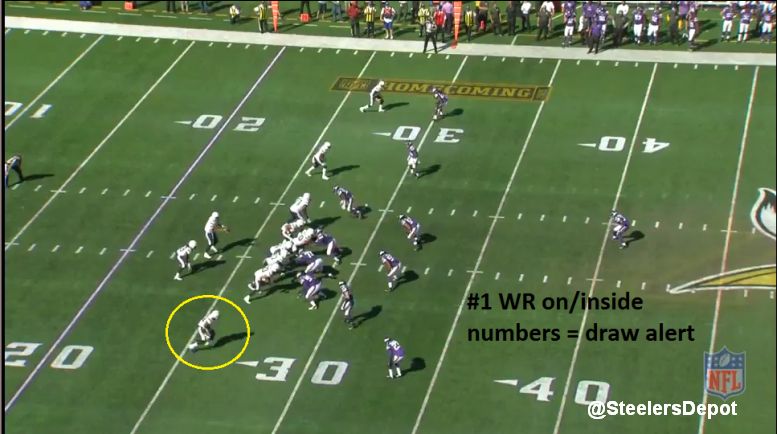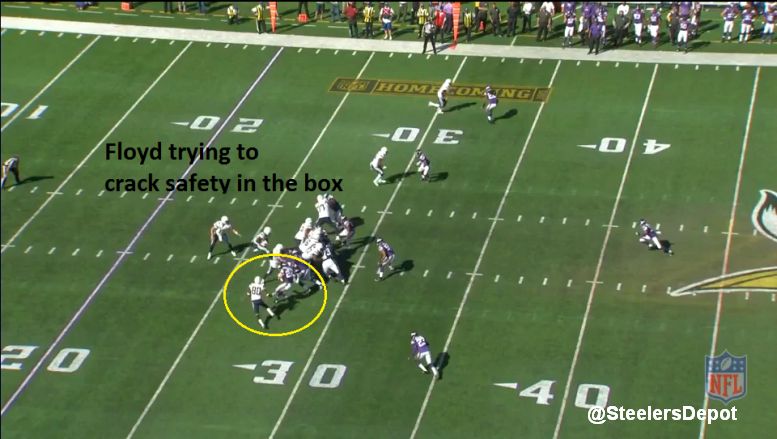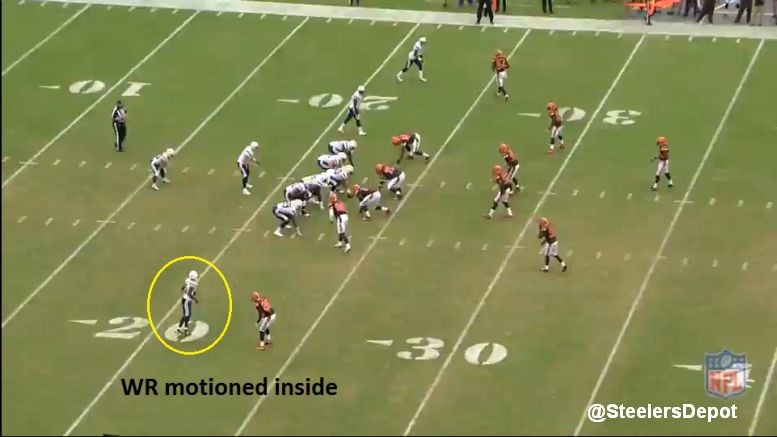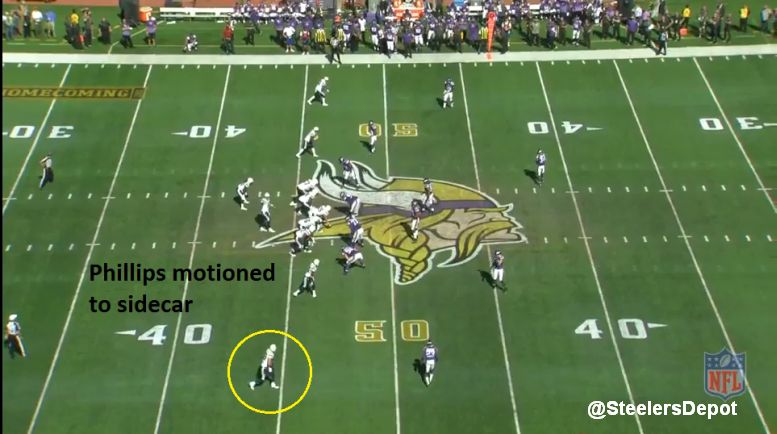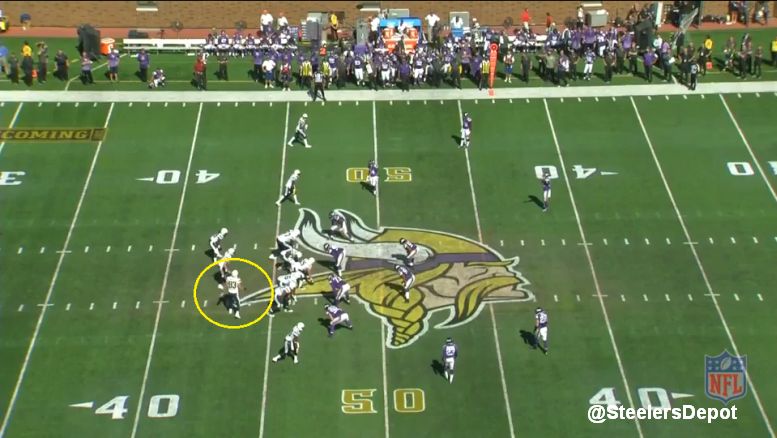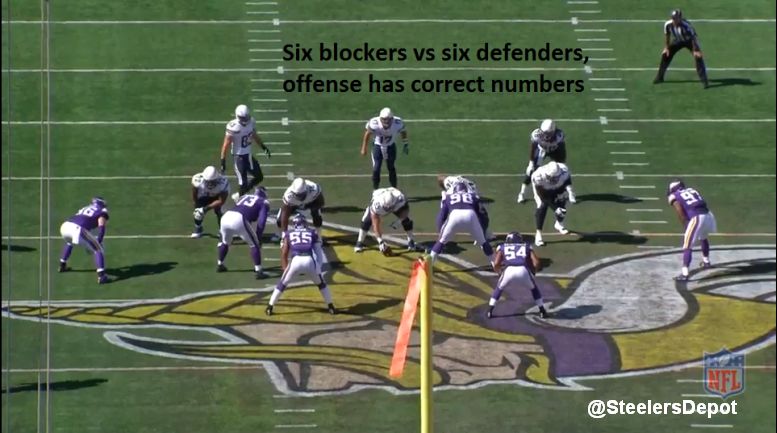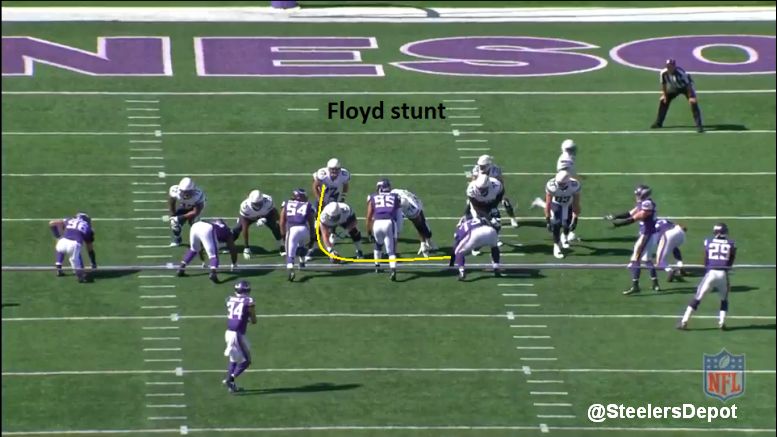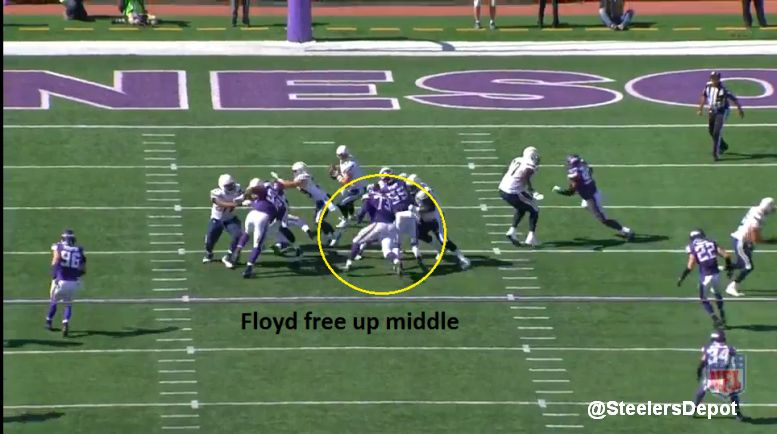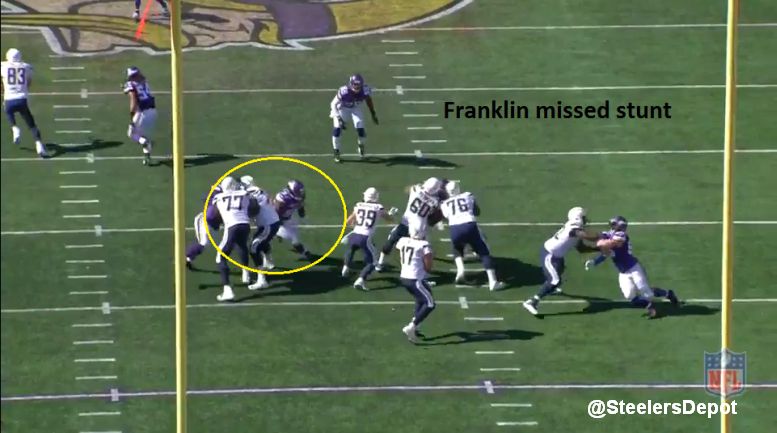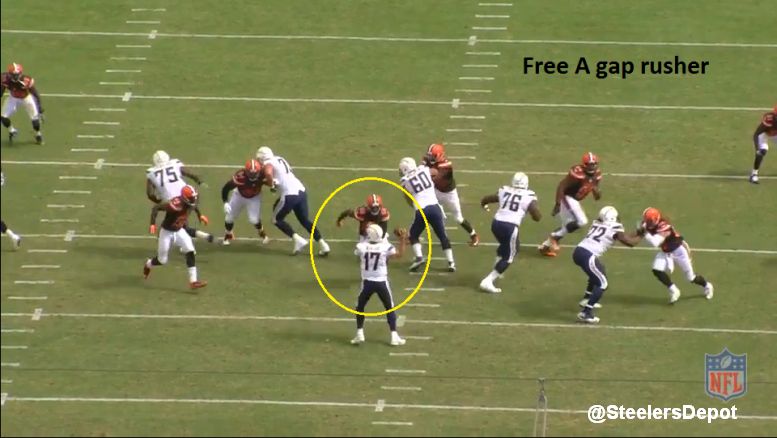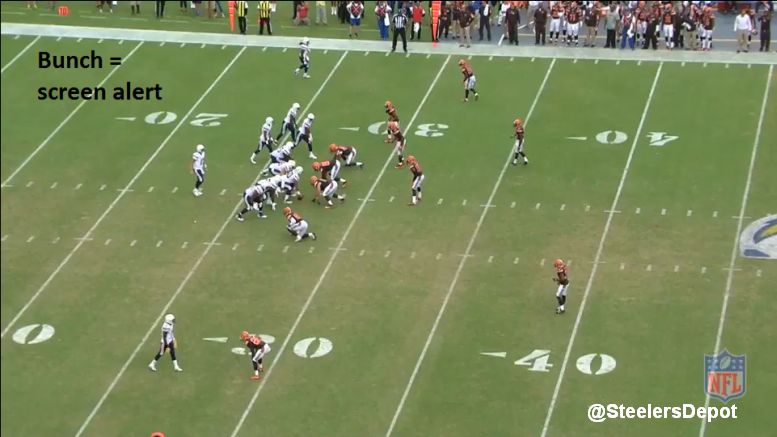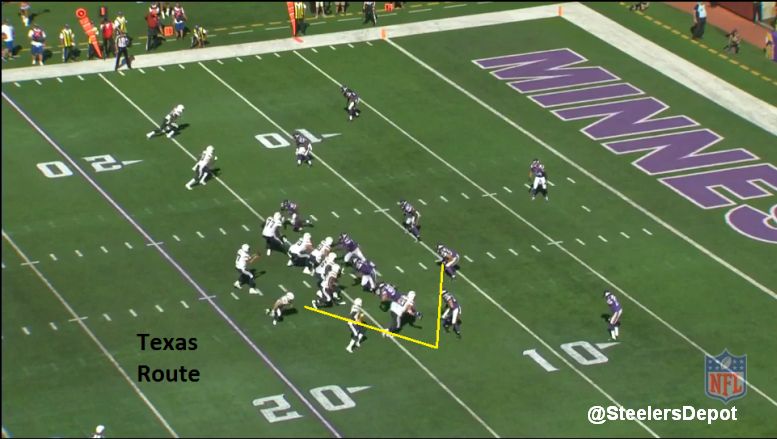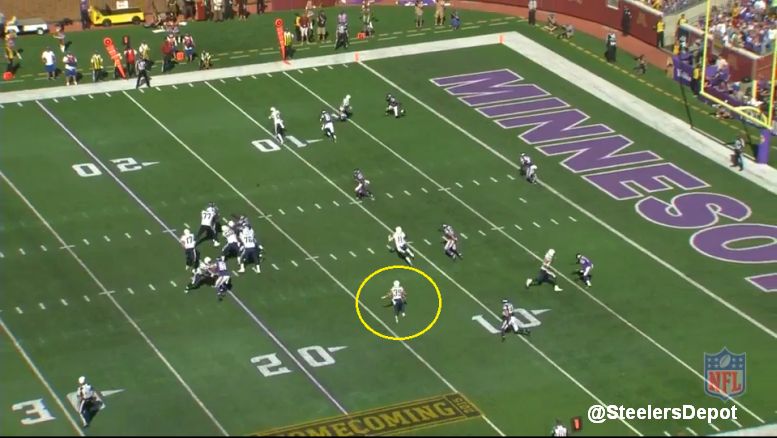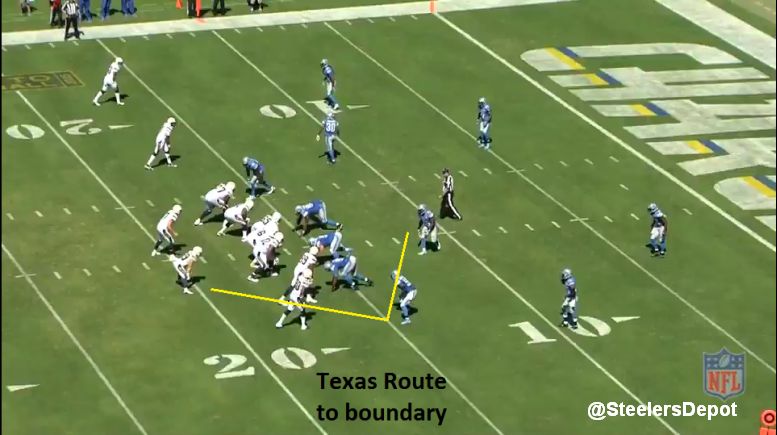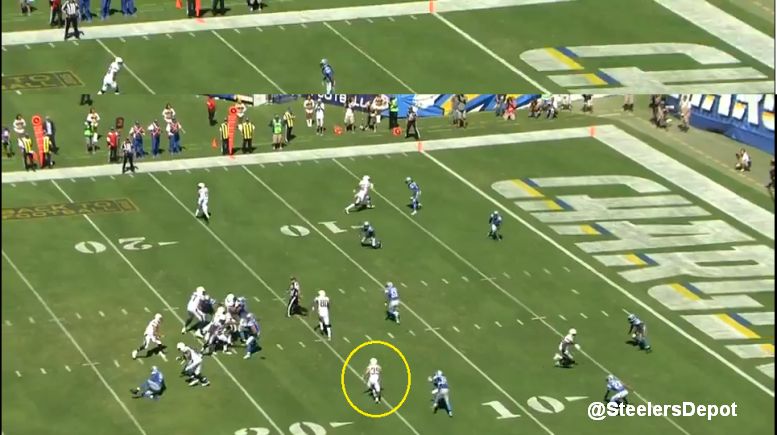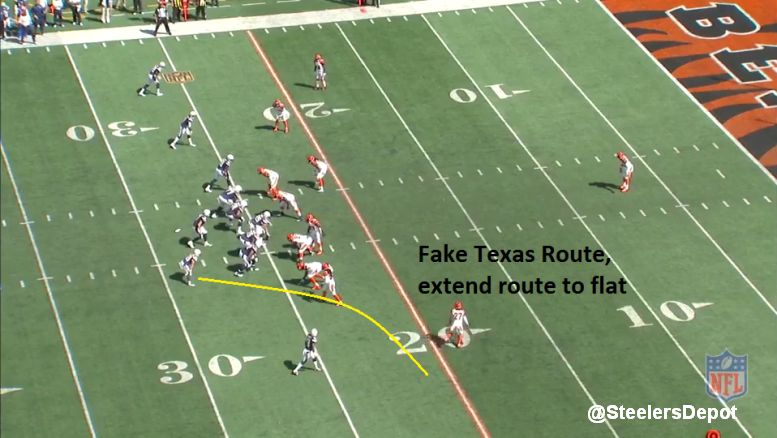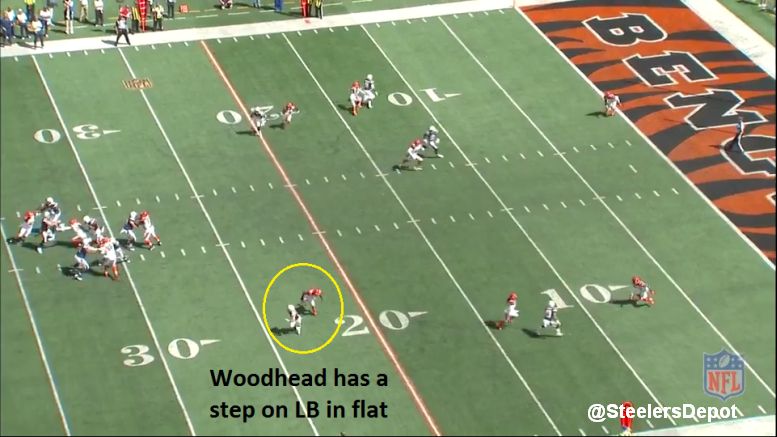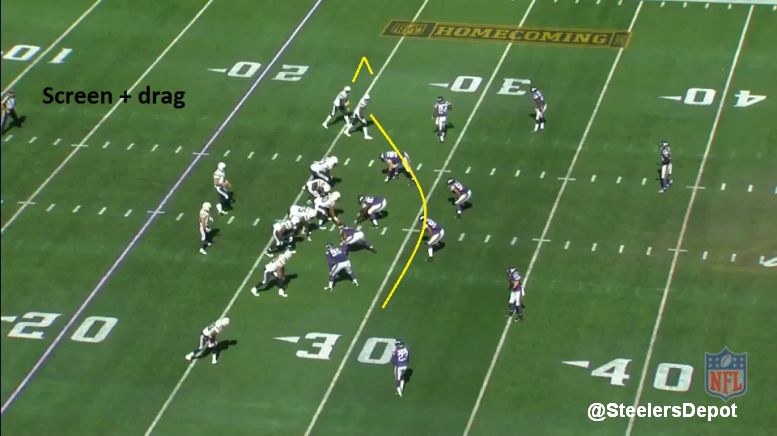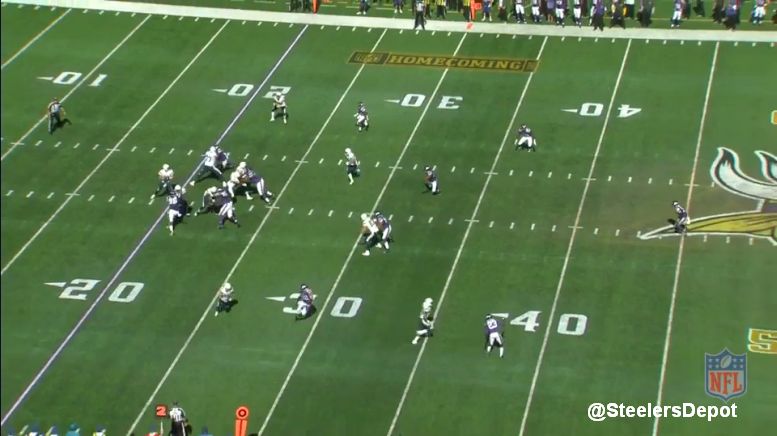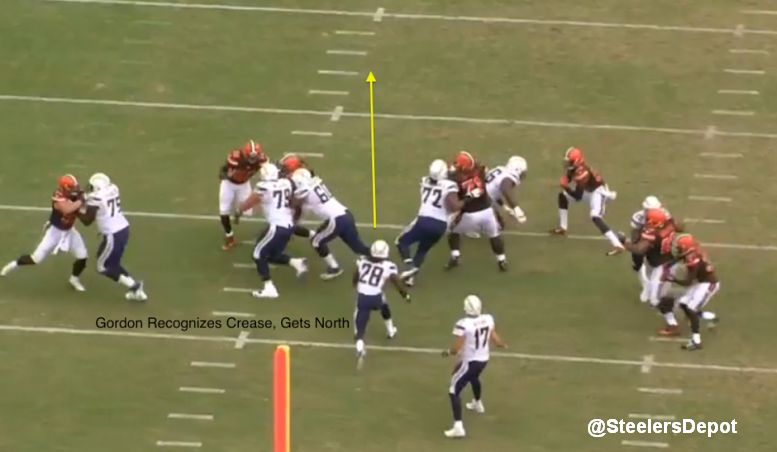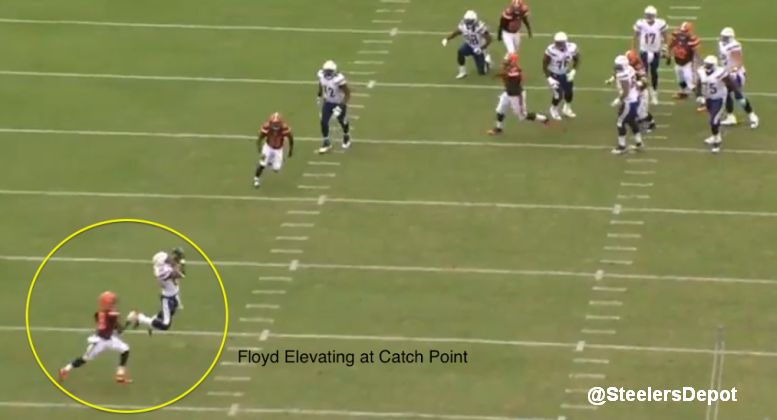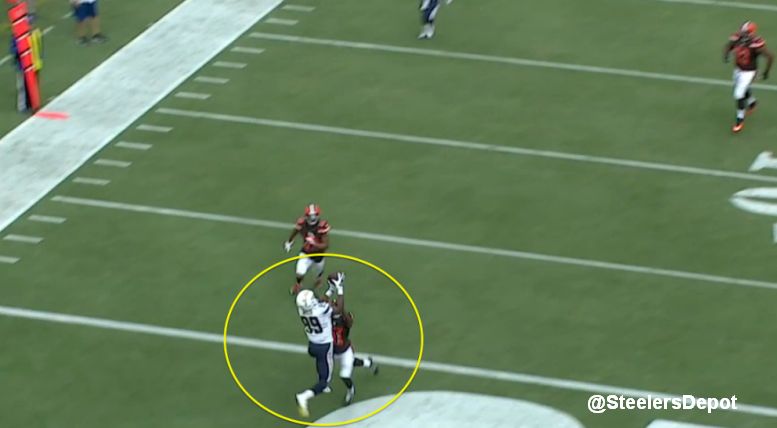This year, Jon Ledyard and I will be collaborating our scouting reports. We’ll play to our strengths – he’ll be focusing on the individuals while I’ll be looking at overall scheme. These reports will be broken down into two articles, one for offense and one for defense.
Our reports for the San Diego Chargers’ offense.
ALEX’S SCHEME REPORT:
San Diego Chargers’ Running Game
Danny Woodhead has been used as both a runner and receiver with 33 carries and 20 targets.
Their run game is less than stellar with only nine runs of 10+ yards, tied for 26th in the league.
At running back, Melvin Gordon has been in a timeshare with Woodhead. But each week, Woodhead has out-snapped the rookie. The splits, with Woodhead’s on the left are as follows: 42/36, 32/29, 33/28, and 36/30.
The Chargers are primarily a man blocking team. There’s a little bit of inside zone but it’s a “plain,” straight-ahead style, mostly out of one-back sets. There was some two-back work in Week Three with ex-Steeler David Johnson at fullback, he even got a carry on 3rd and 1, but with the return of Antonio Gates, I bet Johnson won’t be used much on offense.
They’re an infrequent gap run team. I only saw a power run with a guard pulling twice in the tape I watched. Both of those runs came out of shotgun.
Speaking of shotgun, the Chargers have to be one of the most draw-heavy teams in the NFL. Through four games, they have 58 draws for 278 yards, or 4.8 yards per carry. That means 55.2% of their total rushes have been draws with 68.1% of their yards coming from them. The Chargers have run at least nine in every game, including a pretty incredible 25 in Week One.
Your alert, which of course is not infallible, is the #1 boundary receiver with a reduced split on or inside the numbers. They ask their receiver to crack any safety that comes up into the box, normal rules for any team (stalk vs two high, crack vs single high). This will either be done by pre-snap alignment or motioning a receiver late inside. Both instances can be seen here.
Any sort of backfield shift is also an indication. The draws are box count reads, running vs light six man looks. In empty, Rivers can motion the back to him. Or if he needs another blocker to shore up the numbers, he can bring in tight ends into the backfield, doing so with John Phillips here against the Vikings.
This could apply to the run or pass game but the Chargers’ offensive line has been a MASH unit already. Only one player, right tackle Joseph Barksdale, has played even 70% of the team’s snaps. As a team, the Chargers have only three players over the 90% threshold: Philip Rivers, Barksdale, and Keenan Allen. For reference, the Steelers have seven.
San Diego’s Passing Game
We’ll start with the Chargers from a statistical approach. Philip Rivers is having another fine season. He’s completing an unworldly 70.7% of his passes. His offensive line, marred by injury, hasn’t done him any favors. It should be noted his attempts are high league-wide but he’s been sacked 12 times, or once every 11.7 attempts.
Keenan Allen is unquestionably the Chargers best weapon but Stevie Johnson and Ladarius Green are chain movers. Johnson has 13 first downs on 18 receptions while Green has 11 on 14. Johnson is dinged up and while Gates is returning this week, these numbers are still worth noting.
Malcom Floyd, status also uncertain due to a concussion suffered early last week, is the team’s deep threat. Four of his eight receptions have gone for 20+ yards.
As a team, the Chargers have 17 plays of 20+ yards through the air. That figure ranks fourth in the NFL.
Overall, they do a nice job of taking care of the football. Rivers has only four interceptions in 140 attempts and as a team, they have just one fumble through the first quarter of the year.
I want to start with their offensive line. While Jon has done a great job breaking them down individually, there is one area I want to touch on. Given the revolving door, youth, and probably a lack of talent, the Chargers are not doing a good job recognizing and communicating on stunts. Far too many free rushers and a large source to why Rivers is getting beat up so often.
Here is center Chris Watt missing a T/E stunt, leaving a free rusher up the middle against the Minnesota Vikings in Week Three.
Here is left guard Orlando Franklin missing one a quarter later.
And here’s a linebacker free up the A gap a week later against the Cleveland Browns. Need to pinch the A gaps against this kind of look but the Chargers’ apparent confusion leaves the defender free.
San Diego is a screen heavy team to all sorts of players in all types of formations, personnel groupings, and situations. To outside receivers, slot guys, running backs, they utilize it all.
One screen alert is anytime the Chargers get in a trips bunch look. They add motioning out Gordon wide, though this acts as window dressing on the WR screen.
Steelers have to be able to defend the Chargers’ red zone concepts. One of their favorites is the Texas, or angle, route from their back out of the backfield. They run this primarily in the red zone, to the boundary (short side of the field) and is one of their money plays on 3rd down. The back, of course, is the slippery Danny Woodhead.
An angle route has the running back release out of the backfield with an initial outside stem before cutting back inside, like an angle. Here are two examples.
They’ll play off of that, too, faking the inside stem on 3rd and 12 against the Cincinnati Bengals in Week 2, with Woodhead continuing to the flat, gaining a step on the linebacker.
Don’t have a great name for the concept but will run a smoke screen/drag route in second and short between their own 20-30. Did it twice against the Vikings, going for gains of 16 and 22 yards.
As Mike Tomlin and Todd Haley have spoken to throughout the week, Rivers had complete control over the offense. He loves to use trades, shifts, and motions just to see how you react to it as a defense. I’m not smart enough to breakdown specific examples of the things he’s looking for in the tape I’m watching, but I know why he’s doing it. It isn’t just for that play either. It’s so when he goes back to the sideline, he can tell his OC and players how the defense is playing them – their personality, as Tomlin would quip. It will help their playcalls later in the game. So expect a lot of pre-snap theatrics from him, especially since he’s on his own turf.
San Diego’s Special Teams
Jacoby Jones has been injured, leaving Branden Oliver to kick return duties. He, and punt returner Keenan Allen, have been unimpressive.
Wide receiver Dontrelle Inman and cornerback Patrick Robinson worked as jammers last week. They do appear to be willing to double-vice your most dangerous gunner.
Their punt return rush is less aggressive that the Baltimore Ravens, usually sending six. Jordan Berry should feel more comfortable and have a better performance this week.
Their kick return unit is a similar formation to the Steelers with a 5-1-2-1-2 look. Woodhead serves as Oliver’s upback.
Tight ends John Phillips and David Johnson act as the wings on field goals. Mike Scrifes is the holder. He hasn’t attempted a pass since 2010.
JON’S INDIVIDUAL REPORT:
I typically begin these scouting reports by taking a look at the other team’s offensive line, but San Diego’s revolving door in the trenches had made this task unenviable. Against Cleveland last week, the Chargers were without three of their top five offensive linemen for much of the game due to injury, and suffice to say the unit struggled in the run blocking game. First rushing play of the game for San Diego, three linemen missed their blocks and ended up on the ground, while Cleveland defenders met in the backfield to drop Melvin Gordon for a three-yard loss.
The unit gave up pressure in pass protection, but Phillip Rivers was only sacked twice, both on dual blitzers attacking the Chargers left A-gap. Rivers typically gets the ball out very quickly, so I expect the damage on the offensive line to be felt more in the running game than the passing game.
When the starters are out there, San Diego’s offensive line is among the largest and most powerful in the NFL, featuring 6’8, 330-pound King Dunlap and 6’5, 340-pound D.J. Fluker. A former first round pick, Fluker has made the switch from right tackle to right guard this season, likely a more adept spot for his mediocre foot quickness and agility in space.
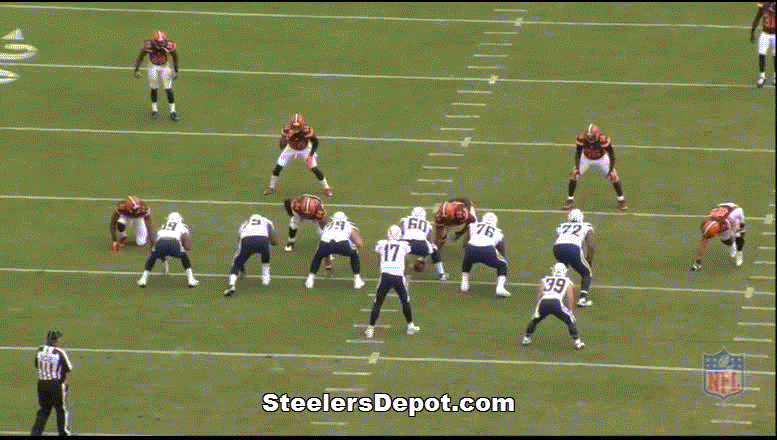
Fluker can’t get to the second level on this combo block and seal the linebacker inside, failing to sustain control of the defender, who makes the tackle. Been an issue with him throughout his career when he has to work in space and hit moving targets. In the trenches he’s a physical mauler, so keeping his clamps off of you is key as a defender.
Dunlap is one of the largest men in the NFL, with a ridiculous wingspan thanks to his over 35-inch arms. His reach allows him to initiate contact often, but he struggles to mirror, with clunky feet and inconsistent hand placement.

Everson Griffen puts him in the spin cycle here, as Dunlap lunges a bit and misses with his punch. He simply doesn’t have the elite feet to make up for technique mishaps.
The rest of the line is solid, but unimpressive. Orlando Franklin is another mauler at left guard, but has given up the most sacks on the team with 2.5. He’ll lunge a bit too, and is at his best in a phone booth, much like Fluker.
Right tackle Joe Barksdale was one of the last free agents of note to be signed to an NFL team this past offseason, joining San Diego two weeks before the draft. I thought it was an underrated pickup at the time, but Barksdale has just been average so far this season. He’s had to play both tackle spots at one time or another due to injury as well.
Center Chris Watt is a second-year player who wins with angles and leverage. Can get beaten up by power rushers, but is a sound technician who wins from the neck up. Only given up half-a-sack this season, but leads the offensive line with three penalties.
Of course, we may not know the health status of everyone but Barksdale until later this weekend, as Watt, Dunlap, and Franklin were all inactive last week, and Fluker played injured against Cleveland. Stephon Tuitt and Cameron Heyward eagerly await.
I was a big Melvin Gordon fan pre-draft, and while he’s started a little slow in the NFL, you could see him making strides the past two weeks. When scouting Gordon I saw strong vision, but he didn’t have to refine it much at Wisconsin because of how massive most of the holes were there. It took him a couple weeks to adjust to NFL-sized holes, but now you can see him identifying creases quicker, making one cut, and getting north in a hurry.
Danny Woodhead is sharing the reps with Gordon right now, and while both players are asked to play roles as a receiver, Woodhead’s game is still much more well-rounded. He can do everything well, and is a constant annoyance for defenses with his ability to leak out of the backfield and create something out of nothing just when you think San Diego’s attack is stymied. As a defense you can’t lose track of him, not when Woodhead has already piled up 347 yards from scrimmage on 33 carries and 16 catches this year. He’s got wheels in the open field too. And he’ll pass protect with the best of them, laying out Vikings linebacker Eric Kendricks with a big hit this year.
Keenan Allen is probably one of the more underrated receivers in the NFL, mostly due to the fact that, until this year, he simply doesn’t create a ton of splash plays. But after a quiet season last year, Allen has exploded onto the scene in his third campaign, grabbing 33 receptions for 387 yards and three touchdowns (he had only four all of last year). Allen has decent size and speed, but is more of a possession type with excellent footwork and separation ability in the short-intermediate range of the field.
You probably remember Stevie Johnson from his days in Buffalo, the very same receiver who blamed God for his dropped touchdown pass in the end zone against the Steelers in overtime many years ago. He doesn’t make headlines like that anymore (thank God), but his quickness and route-running remain some of the best in the league. Allen is their most targeted pass catcher with 44, but Johnson may be their most dangerous.
First order of business for Pittsburgh? Don’t let a linebacker get matched up in the slot against this man.

Johnson can separate against the best of them, but like Allen has concentration issues at times. Both have dropped passes that resulted in pick-sixes this season.
Malcom Floyd is a distinctly different type of threat, who does not possess the quickness of an Allen or a Johnson. Where Floyd does excel is at catch points, where he wins with physicality, length, and excellent hands.
Because Floyd isn’t as shifty as his fellow receivers, he’s become adept at using subtle physicality in his route breaks to work himself free from press coverage. Check out the slight nudge here at the top of his pattern to separate from the defensive back just enough to reel in a big catch over the middle.

It isn’t much, and Floyd does a nice job of not getting his arm extended, but the push does just enough to gain the separation he needs to elevate uncontested and utilize his massive catch radius.
Floyd lacks vertical speed, isn’t quick or elusive in his footwork, and won’t offer much after the catch, but his ability in this area is a big threat. The Chargers big wide receiver has literally created an 11-year career out of his ability to do this one thing well consistently: win 50-50 balls in the air. Pittsburgh will have to be ready to counter in an undersized secondary.
Of course, all that is assuming Floyd and Johnson play on Monday night, which could be an unlikely scenario if they don’t practice againtomorrow. Floyd has been battling a concussion in what has become a re-occurring issue for him, and Johnson is trying to work through a hamstring injury. If they can’t go, expect to see a ton of 13 personnel based on a versatile group of tight ends that can do a little bit of everything as a group.
Dontrelle Inman should fill Floyd’s role, a long, lanky second-year player the team likes a lot as a size/speed guy. Don’t let his WR4 status fool you, Inman can make plays, catching three passes for 88 yards against a pretty talented Browns secondary.
Ladarius Green has been a favorite of NFL gurus on Twitter for many years now, but Antonio Gates four-game suspension to begin the season finally opened the door for the young tight end to play a major role in the San Diego offense. Green has 4.47 speed at 6’6, 240 pounds, which the Chargers will often utilize by placing him in the slot and creating a mismatch against a smaller cornerback or a slower safety. Expect to see a lot of he and Gates flexed, especially if the Chargers are short at wide receiver.
No surprise that Phillip Rivers has spoken so highly of Green’s play over the past few weeks, as this adjustment to an underthrown ball helped defeat the Browns last week and get the Chargers to 2-2. Very fluid athlete with the flexibility and athleticism to make splash plays down the field.
Misfiring throws isn’t something Rivers does often however. I’ve believed for a long time that the Chargers quarterback is one of the top passers in the game, thanks to his ability to throw with touch and velocity on any given toss. Don’t really care about how many playoff games he’s won, I care about what the tape says.
One of my favorite Rivers’ traits is his ability to throw his receivers open with anticipation. Rivers has always done this so well, aided by his unique ability to vary the ball’s trajectory from throw-to-throw. This slingshot delivery to Stevie Johnson is one of my favorite throws of the season despite the drop.

Tight coverage and pocket collapsing in on Rivers, but he hangs in and rifles a bullet to Johnson’s hands in stride without being able to even step into the pass. Look at his feet too. Rivers takes two shuffle steps to the left, then comes off that read at the last second and flicks it on a frozen rope to Johnson in stride as the receiver is moving away from him. Incredibly tough throw to make.
Rivers is a gunslinger, and he will take big risks at times, although he’s far better and knowing when and where to take those chances these days. He’s aggressive throwing into tight windows, knowing he has the velocity to make those passes work more often than not. The tough part about those throws is that if Rivers’ accuracy isn’t spot on, the ball can often be intercepted.

Talk about a dangerous pass into a tight window, but Rivers places this throw perfectly with plenty of zip. Great throw, but Pittsburgh will need to be ready to capitalize should one be slightly awry.
Rivers has thrown four picks this year, but two were right off his receivers hands and into the defenders. He’ll underthrow deep balls at times, but he’s deadly in the short-to-intermediate range. Typically gets the ball out quick, and will work hard to throw it away if he sense pressure coming. Knows his athletic limitations very well, and rarely tries to scramble. True pocket-passer, but Rivers will always stand in to take a shot in order to make a throw. He’s on the short list of toughest passers in the NFL.
In the return game, the Chargers amazingly did not have a single return yard through three games until last week against Cleveland, when Allen picked up five yards on a short return. It should be noted that former Ravens return man and Steeler-killer Jacoby Jones is the normal punt and kickoff man for San Diego, but he’s been out since Week 1 with an ankle injury, and reportedly did not practice on Thursday. Jones has four punt return touchdowns and five kick return touchdowns during his nine-year career. Branden Oliver has averaged 24.6 yards per kickoff return in his place.
In a surprising move this offseason, the Chargers opted to move on without stellar kicker Nick Novak, instead deciding to go with rookie Josh Lambo from Texas A&M. The move has paid off reasonably well so far, as Lambo has nailed 7-8 kicks and 9-10 extra points. He has yet to attempt a field goal longer than 46 yards in the NFL, but his collegiate long was 50 yards on the dot. Something to keep an eye on in case Lambo has to bang one from distance.

